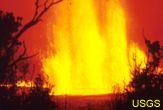Global Warming Likely Cause of Worst Mass Extinction Ever

Despite some controversial evidence that an asteroid or comet caused the worst mass extinction in history, most researchers now believe a combination of volcanic activity and a warming climate was the cause.
New research announced today further supports this majority view.
The Great Dying, as it is called, occurred 250 million years ago, at the end of the Permian Era. More than 90 percent of all species were wiped out. That much is well documented in the fossil record.
In previous work, scientists led by Luann Becker of the University of California, Santa Barbara claimed evidence for impacts by space rocks in layers of Earth dated to the end-Permian event. Several experts on asteroid impacts have doubted those results, however.
The new study, reported Thursday in the online version of the journal Science, found no evidence for impacts. It indicates the culprit was probably atmospheric warming linked to greenhouse gases from erupting volcanoes.
"Animals and plants both on land and in the sea were dying at the same time, and apparently from the same causes - too much heat and too little oxygen," said University of Washington paleontologist Peter Ward, lead author of the latest paper.
It is the second study in less than two months to reach a similar conclusion.
Sign up for the Live Science daily newsletter now
Get the world’s most fascinating discoveries delivered straight to your inbox.
Ward and his colleagues examined Permian-Triassic vertebrate fossils, including 126 skulls from reptiles and amphibians.
They found evidence for a gradual extinction over about 10 million years leading up to the boundary between the Permian and Triassic periods, then a sharp increase in extinction rate at the boundary that then lasted another 5 million years. That's not what you'd expect from a catastrophic asteroid impact, which theorists say could obliterate a lot of life instantly and set up a global winter that would kill off other species in mere months or years.
A search for material expected to be left by an asteroid or comet impact in the same layers of Earth turned up nothing. If there was an impact, it was a relatively minor contributor to the extinction, Ward's team contends.
The work provides a glimpse of what can happen when the climate heats up over long periods, Ward said.
The evidence for a warming planet back then is pretty solid based on studies of continuous volcanic eruptions in an area known as the Siberian Traps. As the planet warmed, large amounts of frozen methane gas under the ocean might have been released to trigger runaway greenhouse warming, Ward said.
"It appears that atmospheric oxygen levels were dropping at this point also," he said. "If that's true, then high and intermediate elevations would have become uninhabitable. More than half the world would have been unlivable."
Atmospheric oxygen, now at about 21 percent of the content of air at sea level, dropped to around 16 percent during the Great Dying, evidence suggests. The effect would be like trying to breathe atop a 14,000-foot mountain.
"It got hotter and hotter until it reached a critical point and everything died," Ward said. "It was a double-whammy of warmer temperatures and low oxygen, and most life couldn't deal with it."
A study out of the University of Vienna, announced in December, also found no evidence for a large space rock collision near the time of the Great Dying.
Robert is an independent health and science journalist and writer based in Phoenix, Arizona. He is a former editor-in-chief of Live Science with over 20 years of experience as a reporter and editor. He has worked on websites such as Space.com and Tom's Guide, and is a contributor on Medium, covering how we age and how to optimize the mind and body through time. He has a journalism degree from Humboldt State University in California.











